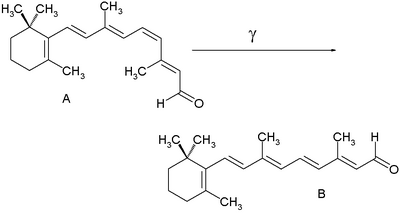Assessment |
Biopsychology |
Comparative |
Cognitive |
Developmental |
Language |
Individual differences |
Personality |
Philosophy |
Social |
Methods |
Statistics |
Clinical |
Educational |
Industrial |
Professional items |
World psychology |
Biological: Behavioural genetics · Evolutionary psychology · Neuroanatomy · Neurochemistry · Neuroendocrinology · Neuroscience · Psychoneuroimmunology · Physiological Psychology · Psychopharmacology (Index, Outline)
In the vision system, retinal, technically called retinene1 or "retinaldehyde", is a light-sensitive retinene molecule found in the photoreceptor cells of the retina. Retinal is the fundamental structure involved in the transduction of light into visual signals, i.e. nerve impulses, in the occular system of the central nervous system.
Overview[]
The molecule that takes part in the initial step in the vision process, rhodopsin, has two components called 11-cis retinal and opsin. Retinal is a light-sensitive derivative of vitamin A, and opsin is a protein molecule. Rhodopsin is found in the rod cells of the eye. When no light is present, the 11-cis retinal molecule is found in a "bent configuration" (fig A), and as such it is attached to the opsin molecule in a stable arraignment. When light strikes the retina, within 200 femtoseconds, after the retinal molecule absorbs a photon into one of the pi bonds found between the eleventh and twelfth carbon atoms, the 11-cis retinal is transformed into the all-trans retinal (fig B) in a straightened configuration:.[1]

Retinal molecule - straightens in response to a photon γ (light), of the correct wavelength
The all-trans retinal configuration, subsequently, does not fit into the binding cite of the opsin molecule; as a result, upon isomerization, the trans isomer separates from the protein, which triggers a G protein signaling pathway' including transducin, that results in the generation of an electrical impulse, which is transmitted through the optic nerve to the brain for processing. It takes a minimum of five photons to trigger a nerve impulse.[2] In the absence of light, enzymes mediate the isomerization of all-trans back to the 11-cis configuration, and rhodopsin is regenerated by a new formation of a Schiff base linkage, which actuates the binding of the cis isomer to opsin. This is the basic mechanism of the vision cycle.
See also[]
References[]
- ↑ Chang, Raymond (1998). Chemistry, 6th Ed., New York: McGraw Hill. ISBN 0-07-115221-0.
- ↑ Feynman, Richard (1985). QED - The Strange Theory of Light and Matter, Princeton, New Jersey: Princeton University Press. ISBN 0691024170.
External links[]
- 1967 Nobel Prize in Medicine - www.nobelprize.org
- First Steps of Vision - National Health Museum
- Vision and Light-Induced Molecular Changes
- Retinal Anatomy and Visual Capacities
- Retinal
[[CategoryPhotochemistry of the retina
| This page uses Creative Commons Licensed content from Wikipedia (view authors). |